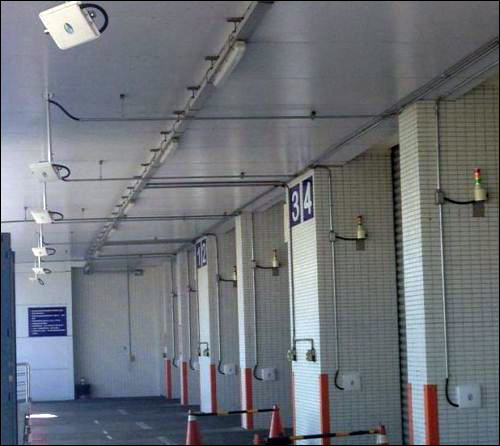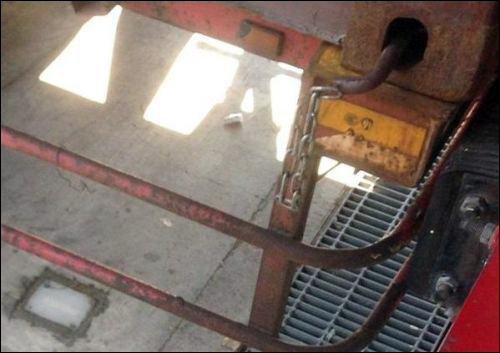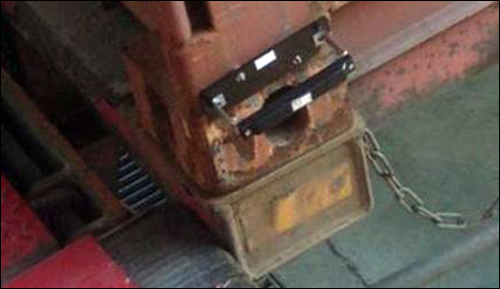LCD flat screen manufacturing company Innolux has installed a passive ultrahigh-frequency (UHF) RFID system to track the arrivals and departures of vehicles and palletized goods at one of its plants in Taiwan. Since the solution was installed in June of this year, the company reports that it has boosted efficiency and reduced the incidence of errors that previously resulted from trucks going to the wrong dock door, or from goods being difficult to locate.
Innolux next plans to install the same system at its factories in China. The implementation consists of Alien Technology readers and UHF RFID tags, provided by EPC Solutions Taiwan. The tags—which were installed in the ground, as well as on forklifts, metal and plastic pallets, and shipping containers—were made by EPC Solutions using Alien Higgs 3 RFID chips. Innolux employs its own software to manage the collected RFID read data.

“This is [our] first warehouse shipping-management system,” says Jacky Chung, Innolux’s manager, “with the most advanced RFID technology installed in the company.”
Established in 2003, Innolux claims to be the world’s largest manufacturer of thin-film transistor (TFT) and LCD displays. Its customers include many leading information technology and consumer electronics manufacturers, such as Dell, Hewlett Packard, Lenovo, LG, Panasonic, Samsung Electronics and Sony.
Innolux has 14 plants in Taiwan, as well as several in China, and manufactures a range of panels and touch-control screens for consumer electronics products, such as televisions, desktop monitors, tablets and a variety of other touchscreen devices. Its operations are complex, the company reports. Some components are partially built at one facility, then are moved to one or more others for additional assembly prior to being shipped to customers. For that reason, trucks come and go from each plant to deliver materials, as well as partially assembled products, and pick up partially assembled or finished goods for customers. Managing trucks’ movements, as well as ensuring that palletized goods are placed on the correct truck, has been a challenging task. The company attempted to use active RFID tags, but found that the technology did not work. The problem was that RF signals transmitted by the tags spilled from one dock door to the next, and the system was unable to discern the specific dock door at which a particular truck or pallet was located.
The company approached EPC Solutions Taiwan for a system that could operate with EPC UHF RFID technology at its main facility. Innolux wanted to know when trucks had arrived, as well as at which door a vehicle was loaded and unloaded. This information would not only create a record of what was received, and from which vehicle, but also identify when an error was being made, in the event that the wrong pallet was being placed onto a truck.
EPC Solutions Taiwan installed 17 Alien ALR-9680 readers, including two at each dock door. One of those two readers, mounted on the ceiling above a dock door’s loading platform, captures the ID numbers of the tags embedded in the ground and attached to shipping containers. The other reader is mounted to the side of the doorway, where it captures the IDs of tags attached to forklifts and pallets.

When a truck arrives at the facility’s gate, the driver first registers with a gate employee, then fills out paperwork indicating what is being picked up or delivered. A UHF tag is attached to the right bottom of the shipping container being hauled by the truck, by means of a magnet. “During the project installation, we had to develop a tag for trucks,” says John Chiu, EPC Solutions Taiwan’s project manager. “It is returnable, durable and easy to remove—and it has to be on metal. So we use magnets instead of glue or screws.” The unique ID number encoded to that tag is stored in Innolux’s RFID software, along with details regarding the vehicle and which goods and materials are being delivered or picked up. The driver then follows instructions from the gate officer to report to the specific dock door at which his or her vehicle is expected. As the worker moves toward the appropriate door, one of three readers captures the shipping container’s tag ID number in order to confirm that the vehicle is traveling in the correct direction.
“A ground tag at each dock door ensures the RFID system does not mistake the location of a truck as it pulls in front of the door,” says Aden Yin, EPC Solutions Taiwan’s senior engineer. When no truck is parked at the loading platform for that door, the Alien reader mounted on the ceiling directly above that ground tag interrogates the tag’s ID constantly, thereby indicating that the dock is empty. When a vehicle backs up to the door, it blocks the tag’s transmission, and the software thus no longer receives that tag ID, which indicates that the truck is at that location. At the same time, the reader captures the tag ID of that truck’s shipping container. The software pairs those two pieces of information, enabling it to determine where the container has been parked.
If Innolux’s software determines that the truck is at the correct location, a light stack at that dock door turns yellow, thereby indicating that it is ready for loading or unloading. When no vehicle is at the dock, the light remains green. If the truck is at the wrong dock door, the light turns red and an audible alert is sounded.
Innolux uses two types of pallets to move materials and products. Metal pallets remain within the company’s network, while plastic pallets come and go from suppliers. An RFID tag was permanently applied to each of approximately 1,000 of the metal pallets. Those that come from suppliers can be tagged temporarily as the goods are moved into the warehouse, and each tag ID is then associated with input order data. Forklifts are also tagged, so the RFID readers installed at the dock doors can identify which forklift loaded which pallet into each truck, for the purpose of maintaining historical data.
When trucks leave the facility, the magnetic tags are removed from their shipping containers. They can then be used on containers being brought in by other vehicles.
Innolux’s software stores data related to each container and the pallets loaded onto it, in addition to which forklift loaded or unloaded that container and at which dock door. In that way, the company can not only capture an alert when a mistake is being made—enabling it to ensure that the wrong goods are never loaded onto the truck—but also retain a history of what occurred in case a question arises. For instance, if a supplier or a customer questions whether something was received or delivered, the EPC Solutions software has stored that information.
“With this RFID auto-scan system,” Chung says, “we do not need to touch any button. The data is there.” This has increased the firm’s efficiency, he explains, since workers now spend less time filling out paperwork or double-checking the goods being loaded into a specific vehicle.
The next step, Innolux reports, will be to equip the company’s other facilities with the technology. The system will first be installed at its Chinese facilities, and is scheduled to then be taken live at the firm’s other Taiwan facilities after that.


